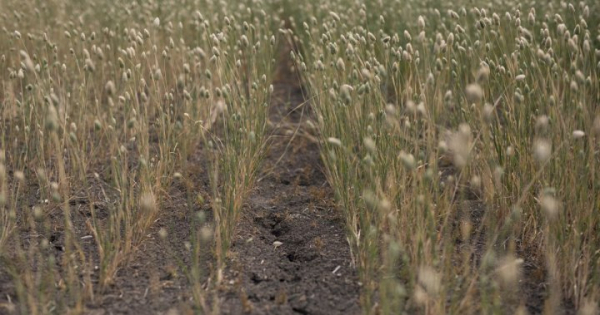Weathering the Storm: The Cost of Climate Change on Canadian Agriculture
In Saskatchewan, the stark financial impact of extreme weather on the agricultural sector has become glaringly evident in recent budget reports. Initially projecting a surplus exceeding $1 billion for the fiscal year ending March 31, 2024, the province now faces an unexpected deficit of approximately $482 million. This abrupt reversal is primarily attributed to drought conditions and the subsequent surge in government crop insurance payouts.
This fiscal turbulence serves as a microcosm of the broader challenges that climate change poses to agricultural sustainability across Canada. With each passing year, taxpayers bear a significant burden as natural disasters disrupt farming operations and strain financial resources. The looming question emerges: who ultimately bears the responsibility for these escalating costs?
Guillaume Lhermie, Director of the Simpson Centre for Food and Agricultural Policy at the University of Calgary, underscores the inevitability of increased government intervention amidst climate-induced adversities. As Canada grapples with a surge in extreme weather events—from droughts and wildfires to heatwaves and flash floods—the need for robust financial support mechanisms becomes ever more pressing.
Crop insurance, a cornerstone of the country's agricultural risk management strategy, offers a safety net for farmers grappling with production losses due to natural calamities. However, as the frequency and intensity of such events escalate, the strain on public coffers intensifies. Saskatchewan's recent budgetary allocations reflect this reality, with significant increases earmarked for crop insurance and farm risk management programs.
Last year's drought in Saskatchewan led to a staggering 11% decline in crop production, resulting in unplanned expenditures exceeding $1.2 billion for the provincial government. Looking ahead, Finance Minister Donna Harpauer acknowledges the imperative of bolstering financial support to mitigate the adverse effects of unpredictable weather patterns on agriculture.
As Canada navigates the uncharted waters of climate change, the resilience of its agricultural sector hinges on proactive measures and equitable distribution of financial responsibilities. The evolving landscape calls for innovative solutions and collaborative efforts to safeguard both farmers' livelihoods and taxpayer interests in the face of mounting climatic challenges.
Navigating the Harvest: Addressing the Financial Fallout of Climate-Induced Agricultural Disasters in Canada
The recurring specter of drought wreaking havoc on Saskatchewan's agricultural landscape is a harsh reminder of the profound financial toll exacted by extreme weather events. In 2021, the province bore witness to one of its most devastating production declines on record—a staggering 47% year-over-year drop—attributed to relentless heatwaves and parched conditions. The Saskatchewan Crop Insurance Program found itself stretched to its limits, disbursing an unprecedented $2.6 billion to beleaguered farmers striving to recuperate their losses.
Yet, Saskatchewan is not alone in grappling with the fiscal fallout of climatic upheavals. Across provincial borders, Alberta's Agriculture Financial Services Corp. (AFSC) confronted a parallel crisis. In 2021, AFSC disbursed $2.1 billion in insurance claims, followed by an additional $552 million in the subsequent crop year, with drought-induced losses dominating the landscape. The impending ripple effect is palpable, with Alberta farmers bracing for elevated crop insurance premiums in 2024, spurred by the fiscal reverberations of preceding years' crises.
Beyond the realm of crop insurance, Canada's federal-provincial-territorial disaster relief framework, AgriRecovery, stands as a bulwark against agricultural calamities. However, the system's efficacy has come under scrutiny, epitomized by its sluggish response times and bureaucratic hurdles. Keith Currie, president of the Canadian Federation of Agriculture, advocates for a comprehensive reassessment of existing risk management mechanisms, citing the urgent need for agile solutions in an era marked by the ubiquity of severe weather events.
The strains of climate change extend far beyond the prairies, reverberating across Western Canada's ranchlands, where dwindling pastures compound the woes of livestock farmers. AgriRecovery, though a vital lifeline, faces criticism for its protracted disbursement timelines, leaving farmers teetering on the brink of financial uncertainty for months on end.
Shannon Sereda, director of government relations for Alberta Grains, underscores the imperative of proactive governmental intervention. While crop insurance remains indispensable, Sereda advocates for a paradigm shift towards robust investment in agricultural research, offering a proactive bulwark against the caprices of climate change. Enhanced research initiatives promise not only resilience in the face of adversity but also the cultivation of sustainable agricultural practices capable of weathering the storms of tomorrow.
As Canada confronts the immutable reality of climate change, the imperative of bolstering agricultural resilience looms large. Through concerted efforts spanning research, policy reform, and financial innovation, the nation can forge a path towards a more resilient and sustainable agricultural future.
Cultivating Resilience: The Imperative of Research and Innovation in Mitigating Agricultural Risks
Amidst the relentless onslaught of climate change-induced disruptions, stakeholders within Canada's agricultural sector advocate a paradigm shift towards proactive solutions anchored in research and innovation. Shannon Sereda, director of government relations for Alberta Grains, champions the pivotal role of scientific inquiry in fortifying the sector's resilience against climatic vicissitudes. She underscores the transformative potential of research-driven interventions, citing advancements like drought-resistant seed varieties as instrumental in curtailing climate-induced crop failures.
For farmers like Stewart Oke, whose livelihood hinges on navigating the tempestuous terrain of Alberta's "Hail Alley," crop insurance serves as a lifeline against unforeseen losses. Oke acknowledges the financial strain borne by both producers and governments in upholding this indispensable safety net. However, he maintains that sustained investments in research and technology are paramount to ensuring the program's viability over the long term. Empowered by innovative tools and practices, producers can navigate risk with greater efficacy, mitigating the need for extensive government intervention.
Guillaume Lhermie, a professor at the University of Calgary, underscores the inevitability of increased government expenditure in shoring up the agricultural industry's resilience against extreme weather events. However, he advocates for a strategic shift towards incentivizing environmentally sound practices as a means of fostering sustainable agricultural systems. Lhermie proposes a novel approach whereby financial support for farmers is contingent upon adherence to prescribed environmental standards, such as soil health and biodiversity management. Such measures, he contends, offer a dual benefit: safeguarding the land while mitigating the fiscal burden borne by governments in the wake of agricultural disasters.
As Western nations grapple with the mounting costs of climate change-induced disruptions, the imperative of forging a sustainable path forward grows ever more pressing. By embracing research-driven innovation and incentivizing environmental stewardship, Canada can chart a course towards agricultural resilience, safeguarding both the land and the livelihoods of its farmers in the face of an increasingly unpredictable climate.
In conclusion, the challenges posed by climate change to Canada's agricultural sector are formidable, but not insurmountable. Through a concerted effort to invest in research and innovation, coupled with strategic policy interventions, the nation can bolster its resilience against the vagaries of extreme weather events. By harnessing the transformative potential of scientific inquiry and incentivizing environmentally sustainable practices, stakeholders can forge a path towards a more resilient and prosperous agricultural future. As we navigate the complexities of a changing climate, the imperative of collaboration and forward-thinking action becomes increasingly clear. Together, we can cultivate resilience, safeguarding the livelihoods of farmers and the integrity of our agricultural landscapes for generations to come.






